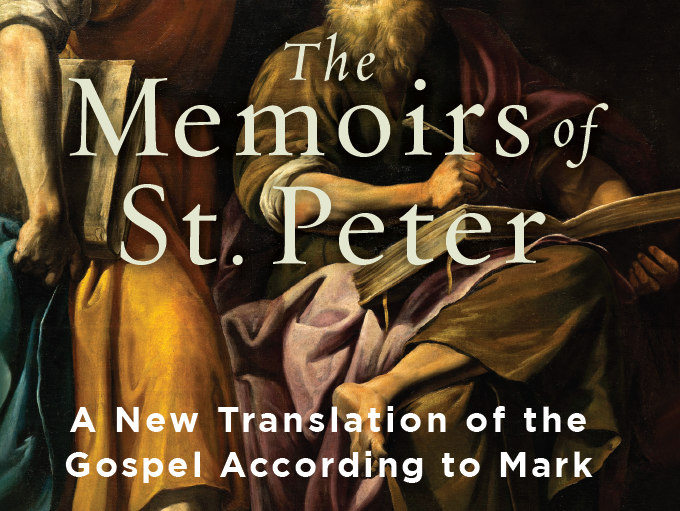A new translation of Mark’s Gospel was published recently that I find very appealing: The Memoirs of St. Peter: A New Translation of the Gospel According to Mark, by Michael Pakaluk.
As the title acknowledges, most scholars consider Mark’s Gospel to be that of Simon Peter. Tradition says that Mark was Peter’s secretary or scribe, and the recollections he recorded are really those of Peter.
One of the things that make Mark’s Gospel unique is its sense of immediacy. Part of this is due to his frequent use of the word “immediately” (eutheos in Greek)—more than forty times in what is the shortest of the four Gospels. Here are just a few examples:
-
- And immediately the Spirit drove [Jesus] into the wilderness (Mk 1:12).
- And when He had gone a little further, He saw James the son of Zebedee, and John his brother, who also were in the ship mending their nets, and immediately He called them (Mk 1:19-20).
- And they went into Capernaum; and immediately on the sabbath day He entered into the synagogue and taught (Mark 1:21).
Another aspect of the Gospel of Mark contributing to its vibrancy and sense of immediacy is Mark’s tendency to render things in the present tense. Here is how Michael Pakaluk describes it:
Mark varies his verb tenses in apparently unpredictable ways. Sometimes he uses the present tense, sometimes the imperfect, sometimes the “aorist.” Most translations solve the problem by throwing everything into the past tense. And yet this removes the vividness that Mark’s frequent use of the historic present conveys. But when one approaches the text as originally a spoken narrative, one can generally retain Mark’s tense changes …. Someone speaking from memory … will change tenses to keep the hearer’s attention, but mainly because, as he is speaking “from memory,” he finds it easy to revert to the viewpoint of what it was like to be there (Introduction 24-25).
That is one of the things that make this new translation so interesting and refreshing. It puts the reader right into the scene, watching the action unfold. Consider Pakaluk’s translation of the beginning of Mark Chapter 3:
He entered the synagogue again. A man with a withered hand was there. They were watching him intently, to see if he would heal the man on the Sabbath, so they could accuse him. So Jesus tells the man with the withered hand, “Stand up in the middle.” He says to them, “Is it allowable, on the Sabbath, to do good or to do evil? To save a life or to put to death?“ They were silent. He looks around at them with anger, pained that their hearts are like stone, and he says to the man, “Stretch out your hand.” The man stretched it out. His hand was restored to normal. The Pharisees walk out, and immediately started to scheme against him, with the Herodians, to find some way to destroy him (Mark 3:1-6).
Notice the calm shifting between the past tense and the “historic present.” It is as if we are there in the room witnessing the events while our interpreter and storyteller, Mark, adds commentary for us.
Pakaluk’s skillful translation makes the text new and vibrant for me. It is like listening as Mark (who records Peter’s preaching) speaks directly to me. Engendering such a feeling is important because the Gospels are not meant to be like “spectator sports.” We are not just watching the lives of others unfold; this is our life, too. We are in the Gospel narrative: we are Peter; we are Mary Magdalene. These are not just distant events being recalled from memory; they are made present to us and become our story, too.
Another aspect that makes Mark’s Gospel so interesting and narrative-like is his use of the Greek work “kai.” Pakaluk describes it in this way:
In Greek, sentences in a continuous narrative must be joined, each with the one before, through a “connecting particle,” such as “hence,” “now,” “therefore,” “but,” and so on. Writers of ancient Greek typically vary these connectors for subtlety and argument. But Mark is famous for largely limiting himself to one such connective—the simplest one, at that—“and” (kai). The majority of the sentences begin with “and.” Translators usually deal with the problem by just leaving the word out. But Mark’s usage makes more sense if we think of how we speak when we tell a story: “So I left my driveway. And I turned around the block. And I saw a man with a pig. And I thought it was strange. So I stopped to ask him about it. And he said…” And so on (Introduction 24).
In this new translation of Mark, Pakaluk retains a lot more of the “and” (kai) connectors, varying its translation just a bit for variety: “and,” “so” “once again,” and so forth. This retention of “kai” also adds to the narrative or storytelling quality of the text.
I am very grateful for this fresh translation of the Gospel of Mark and hope you find it as helpful as I do. Along with the new translation, Pakaluk provides solid commentary that includes the consideration of many different interpretations of the text. If you (or perhaps your Bible study group) are looking for an interesting and informative book, consider this one.
Cross-posted at the Catholic Standard: A New Translation of Mark’s Gospel


Michael Pakaluk’s translation of St. Mark’s Gospel sounds as fresh and tasty as still-hot dishes brought for consumption at a church pot-luck dinner.
Very interesting – thank you! I made a quick comparison of the beginning of chapter 3 in the handy online Vulgate translastion with interlinear Douay-Rheims translation of it, and found that rewarding. (Here, the Latin and its translation keep ‘kai’ (as ‘et’ and ‘and’) even more times than Michael Pakaluk!) It is an attractive prospect to have his ‘Memoirs’ in hand to do some more of this, and to read the introduction and commentary in full.